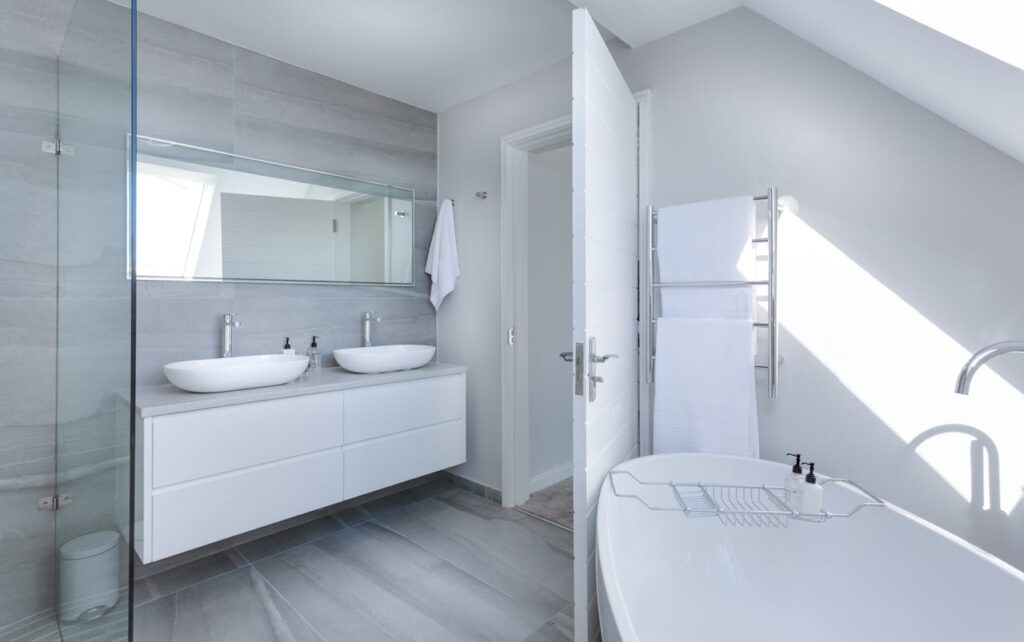Introduction to Barrier-Free Bathrooms
In today’s progressive society, the importance of accessible spaces is ever-growing, and bathrooms are at the core of this transformation. More than just a remodeling trend, designing for accessibility ensures that everyone, regardless of age, physical ability, or specific needs, can enjoy comfort and safety in one of the most critical parts of any home. A barrier-free bathroom focuses on achieving a delicate balance between utility and style, allowing these spaces to meet a wide range of requirements without sacrificing aesthetics. Implementing changes like a walk-in shower installation exemplifies how minor adjustments can lead to major improvements, providing seamless integration of accessibility for those who find traditional bathrooms challenging. Thoughtfully designed, these spaces transcend functionality, transforming into essential areas that significantly enhance everyone’s living experience.
Today, more homeowners realize the potential of thoughtfully designed bathrooms—they are practical and supportive and bring a touch of elegance to any home. Adopting a universal design perspective enables your home to serve as a sanctuary for everyone, fostering independence while perfectly maintaining modern, stylish aesthetic elements.
Safety First: Essential Features
Safety remains a key element in bathroom design, especially when the goal is accessibility. Essential safety features, such as non-slip flooring, well-placed grab bars, and curb less showers, significantly minimize the risk of slips and falls. Consider incorporating a walk-in shower installation, a notable improvement ensuring safe and easy access for everyone. The details extend to even the smallest features; strategically located grab bars can make a substantial difference in security and support. Additionally, thoughtful placement of these elements enhances overall accessibility, creating a truly accommodating space for all users.
Modern Design Trends for Accessibility
Bringing modern design trends into accessible bathrooms is reshaping our perception of these spaces. Accessibility is no longer synonymous with stark, purely functional aesthetics. Instead, contemporary designs incorporate sleek fixtures and elegant layouts rivaling high-end, non-accessible bathrooms. Features such as open layouts support improved mobility, while low-profile fixtures enhance the bathroom’s functionality and contribute significantly to its sophisticated allure. By aligning with current trends, homeowners can effortlessly integrate these styles, ensuring their bathroom is a haven and a visually pleasing space shot through with comfort and class.
DIY Modifications for Enhancing Accessibility
On the more approachable transformation spectrum come DIY modifications, which are cost-effective ways to boost accessibility without extensive construction. Several simple yet impactful changes can bring significant relief and accessibility to your space. Installing a handheld showerhead grants flexibility and independence in bathing routines while adjusting cabinet heights to more reachable levels eases interactions. Furthermore, adding motion-activated lights enhances convenience and safety, making night-time bathroom visits hassle-free. These simple changes illustrate how resourcefulness and creativity can foster accessibility, proving that one doesn’t always need a substantial budget to effect meaningful change.
Professional Upgrades for Barrier-Free Living
While DIY projects have their place, professional upgrades offer robust, long-term solutions precisely tailored to individual needs. The involvement of professionals brings expertise and precision in installing complex features, such as seamless flooring transitions and custom fixtures tailored to fit personal requirements. The structural upgrades, including widening doorways to allow more room for mobility aids, provide improved functionality and ensure a high accessibility standard. Lean on specialists to create comprehensive designs focusing on lasting comfort and safety.
The Role of Technology in Smart Bathrooms
Technology is at the forefront of modern improvements, consistently redefining what’s possible in bathroom accessibility. Cutting-edge innovations, like smart showers with automatically adjustable water temperatures and voice-controlled lighting systems, transform bathrooms into tech-savvy spaces that cater to a wide range of needs. These technological advances are no longer exclusive to ultra-modern or luxury residences but are becoming more accessible to everyday homeowners. As these solutions become more widespread, the barriers to independent living continue to be dismantled, enhancing daily bathroom activities for individuals with diverse needs and capabilities. Thus, embracing technology ensures an inclusive bathroom experience and elevates comfort, convenience, and autonomy in everyday life.
Incorporating Style with Functionality
There’s a growing movement towards embracing the harmony of form and function of inaccessible bathrooms. Today’s designs emphasize selecting elements that ensure safety while maintaining style, from non-slip floors in various finishes to chic faucets and fixtures that double as bathroom accents. Carefully chosen materials and palettes, such as neutral tones mixed with natural materials, transform the bathroom into a serene, stylish retreat. This approach balances aesthetic appeal with practical utility, keeping the space as elegant as it is accessible. By dedicating care to craftsmanship and selection, homeowners can curate a bathroom environment that is both inviting and fully accommodating.
Real-Life Examples of Accessible Design
Real-life implementations of accessible design offer a rich source of inspiration, demonstrating that functionality and elegance coexist harmoniously. Many homeowners have embraced barrier-free principles, sharing their creative solutions in home design magazines, online platforms, and TV renovation shows. Whether it’s space-efficient layouts or aesthetically pleasing modifications, these case studies highlight the significant impact of thoughtful design choices on daily living. Through these examples, the practicality and beauty of accessible design are revealed, enlightening those looking to make similar improvements. These stories underscore the profound influence that accessible, thoughtfully designed spaces exert, significantly enhancing the quality of life without compromising style.
For more Informative articles you can visit our blog royalsprinter.com
See Also:

